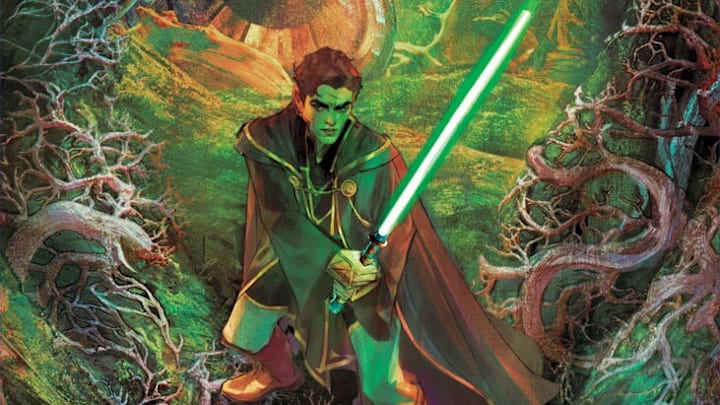Star Wars: The High Republic: Into the Light by Claudia Gray is the final young adult novel in The High Republic publishing initiative. It is a satisfying, thrilling, heartfelt, and essential chapter in the overarching story. As the title Into the Light would suggest, many of the novel's elements come full-circle with The High Republic's first young adult novel Into the Dark by Claudia Gray.
When the blight is discovered on the Wookiee home world of Kashyyyk, and the Jedi receive intel that the ruthless Nihil scientist Dr. Mkampa is there, a team is dispatched to deal with the situation. Reath Silas, who first appeared during Into the Dark and who has been investigating the blight, is critical to this mission, and recruits several key characters who were introduced during that book as well. Along with the blight and Dr. Mkampa, the team is threatened by the carnivorous Drengir, who were unleashed on the galaxy during Into the Dark.
The team also fittingly includes the Wookiee Jedi Burryaga Agaburry and Kelnacca, the latter of whom was first introduced in The Acolyte. While Kelnacca has appeared in some High Republic comics, it is rewarding to spend a more ample amount of time with him over the course of a novel. It is also fascinating to see how Burryaga and Kelnacca navigate their dual roles as Jedi and as Wookiees temporarily returning home.
While Into the Light features many character point of views, the story is mostly contained to Coruscant before the mission, and to Kashyyyk once Reath, Burryaga, Kelnacca, and the rest of their team arrive there. This leads to a more contained and character-driven story as opposed to the more expansive galactic scope of the adult novels.
The amount of time spent on Kashyyyk allows Into the Light to deeply explore the planet, even revealing secrets and aspects of Wookiee culture that have not been included in other Star Wars stories set there. Kashyyyk practically becomes its own character, which makes it even easier to be invested in the efforts to save the planet.
One of these secrets involves introducing yet another formidable threat, which arguably feels excessive since the characters are still dealing with the Nihil, the Nameless, the Blight, the Stormwall, and the Drengir, all while The High Republic is supposed to be nearing its conclusion. However, this new threat is effectively foreshadowed and cleverly connects to the ongoing dangers.
The setting of Kashyyyk and the secrets it reveals allow certain characters to be the most compelling they have ever been. I found this to be particularly true for the former Jedi Azlin Rell, the Nihil's Nan, and the Vessel's navigator Geode. Any time Geode shows up is enjoyable, but Gray is particularly adept at writing the unique character with a perfect balance of comedy and sincerity, which leads to a surprising payoff this time around.
The only downside to having such a large team of characters is that some do not get as much focus or development as others. Cohmac Vitus and Amadeo Azzazzo, who were main characters alongside Reath in Tears of the Nameless by George Mann, do not get as much to do this time around, although they still play meaningful roles.
Into the Light is primarily concerned with its characters and solving the problems threatening Kashyyyk. At the same time, cracks are clearly beginning to form within the Nihil and the seemingly unbreakable hold Marchion Ro had over the galaxy. Scientist Avon Starros also makes a discovery that is poised to be integral to the endgame in Trials of the Jedi by Charles Soule. Most of The High Republic's biggest plot points are definitely being saved for Trials of the Jedi, but Into the Light still has a deeply fulfilling ending.
As much as I liked the story in Light of the Jedi, it was not until Into the Dark that I fell in love with The High Republic's characters. Seeing how far Reath and the others have come over the years is incredibly satisfying. I still expect to see many of them in the remaining novels and comics, but Into the Light is an excellent conclusion for the majority of their emotional arcs.
